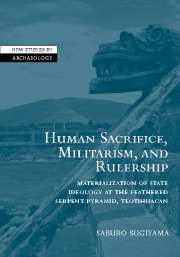 Human Sacrifice, Militarism, and Rulership
Human Sacrifice, Militarism, and Rulership Book contents
- Frontmatter
- Contents
- List of figures
- List of tables
- Acknowledgments
- 1 Introduction: cognition of state symbols and polity
- 2 Background: data and ideation
- 3 The Ciudadela and the city layout
- 4 Architecture and sculpture
- 5 Burials
- 6 Offerings
- 7 Overview: sacrificial and elite burials
- 8 Conclusion: the Feathered Serpent Pyramid as symbol of sacrifice, militarism, and rulership
- Notes
- References
- Index
2 - Background: data and ideation
Published online by Cambridge University Press: 22 September 2009
- Frontmatter
- Contents
- List of figures
- List of tables
- Acknowledgments
- 1 Introduction: cognition of state symbols and polity
- 2 Background: data and ideation
- 3 The Ciudadela and the city layout
- 4 Architecture and sculpture
- 5 Burials
- 6 Offerings
- 7 Overview: sacrificial and elite burials
- 8 Conclusion: the Feathered Serpent Pyramid as symbol of sacrifice, militarism, and rulership
- Notes
- References
- Index
Summary
In the first half of Chapter 2, I describe the history of excavations and interpretations of the Feathered Serpent Pyramid (FSP) to demonstrate the different qualities of data analyzed. I evaluate the research contexts, since contextual details are often crucial for the reconstruction of ritual behavior in time and space. An action is sometimes imprinted between layers and can be restored through careful interpretation of its archaeological context. In the second half, I review Mesoamerican cosmology, to provide a background for what ritual meanings we might expect to find at the Ciudadela and the FSP. The following chapters are efforts to build a bridge between the data and ideational realms outlined here.
Excavations at the Feathered Serpent Pyramid
The pyramid was separately excavated by several archaeologists at different times. Graves found in and around the pyramid were reported as independent graves unrelated to each other. Since 1985, however, I have believed that almost all these graves were part of a sacrificial burial complex associated with the building of the pyramid (Sugiyama 1986 and 1989a). My hypothesis of a cohesive relationship among the burials is analyzed with new, more detailed data in Chapters 5 and 6. In this section, excavation contexts are discussed and in some cases reinterpreted. The cohesiveness of the architecture, graves, and caches found around the FSP, and related stratigraphy, is also discussed.
- Type
- Chapter
- Information
- Human Sacrifice, Militarism, and RulershipMaterialization of State Ideology at the Feathered Serpent Pyramid, Teotihuacan, pp. 18 - 37Publisher: Cambridge University PressPrint publication year: 2005


